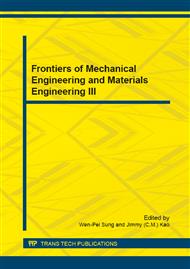[1]
J. Biet, M. Ndem, M. ldir et al, Ignition by electric spark and by laser-induced spark of ulter-lean CH4/air and CH4/CO2/air mixtures at high pressure,J. Combust, J. Sci. Technol, 186(2014)1-23.
DOI: 10.1080/00102202.2013.840296
Google Scholar
[2]
A. Nishiyama, A. Moon, Y Ikeda et al, The ignition characteristics of methane/air premixed mixture by microwave-enhanced laser-induced breakdown plasma, J. Optics express, 21(2013)S6.
DOI: 10.1364/oe.21.0a1094
Google Scholar
[3]
J. Tauer, H. Kofler, E. Schwarz et al. Transportation of megawatt millijoule laser pulses via optical fibers? ,J. Cent. Eur. Phys, 8(2010)242.
DOI: 10.2478/s11534-009-0146-1
Google Scholar
[4]
S.B. Gupta, B Bihari, R Sekar et al. Ignition characteristics of methane-air mixtures at elevated temperatures and pressures, J. SAE Technical, 2005-01-2189.
DOI: 10.4271/2005-01-2189
Google Scholar
[5]
M. Weinrotter, G. Ast, H. Kopecek et al, An extensive comparison of laser-induced plasma ignition and conventional spark plug ignition of lean methane-air mixtures under engine-like conditions, J . SAE Technical, 2005-01-0248.
DOI: 10.4271/2005-01-0248
Google Scholar
[6]
J.X. Ma, D.R. Alexander, D.E. Poulain, Laser spark ignition and combustion characteristics of methane-air mixtures , J. Combust and Flame, 112 (1998) 492–506.
DOI: 10.1016/s0010-2180(97)00138-7
Google Scholar
[7]
P.D. Ronney, Laser versus conventional ignition of flames, J. Optical Engineering , 33(1994) 510.
DOI: 10.1117/12.152237
Google Scholar
[8]
G.P. Tewari, J.R. Wilson. An experimental study of the effects of high frequency electric field on laser-induced flame propagation , J . Combustion and Flame , 24(1975)159–167.
DOI: 10.1016/0010-2180(75)90143-1
Google Scholar
[9]
T. X Phouc, F. P White. Laser-induced spark ignition of CH4/air mixtures , J . Combust and Flame, 119 (1999) 203–216.
DOI: 10.1016/s0010-2180(99)00051-6
Google Scholar
[10]
S. Kondo, K. Takizawa, A. Takahashi et al, Extended Le Chatelier's formula for carbon dioxide dilution effect on flammability limits, J . Hazard. Mater, 138(2006)1.
DOI: 10.1016/j.jhazmat.2006.05.035
Google Scholar
[11]
B. Lewis, G. von Elbe, Combustion, Flames and Explosions of Gases, 3rd ed. Academic Press, New York, (1987).
Google Scholar
[12]
J.L. Beduneau, B. Kim, L. Zimmer et al, Measurements of minimum ignition energy in premixed laminar methane/air flow by using laser induced spark, J. Combustion and flame, 132(2003)653-665.
DOI: 10.1016/s0010-2180(02)00536-9
Google Scholar
[13]
E.H. Lim, A. McLLroy, P.D. Ronney et al. In Transport Phenomena in Combustion (S. H. Chan, Ed. ), Taylor & Francis, London, UK, 1996, p.176.
Google Scholar
[14]
D. Bradley, C.G.W. Sheppard, I.M. Suardjaja, et al. Fundamentals of high-energy spark ignition with lasers, J. Combustion and Flame, 138(2004)55-77.
DOI: 10.1016/j.combustflame.2004.04.002
Google Scholar
[15]
K. Dharamshi, A. Pal, A.K. Agarwal. Comparative investigation of flame kernel development in a laser ignited hydrogen-air mixture and methane-air mixture, J. International journal of hydrogen energy, 38(2013)10648-10653.
DOI: 10.1016/j.ijhydene.2013.06.044
Google Scholar


